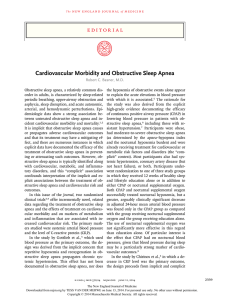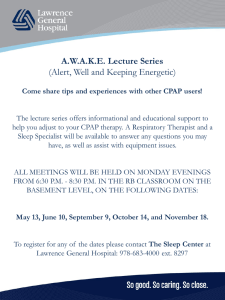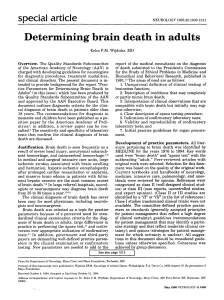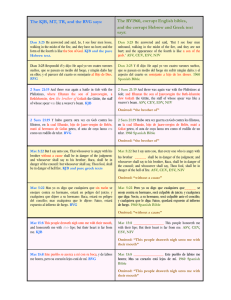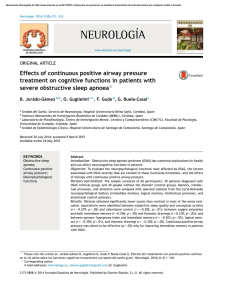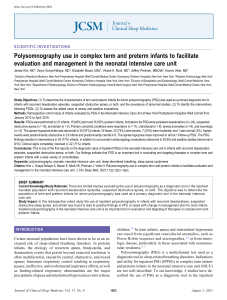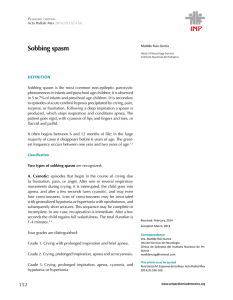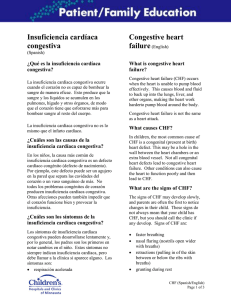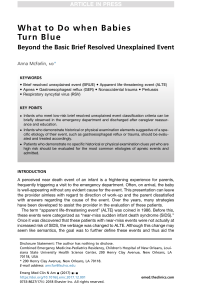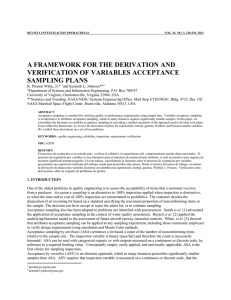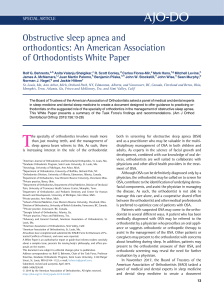CHEYNE-STOKES, APNEAS COMPLEJAS Y CENTRALES USO DE
Anuncio
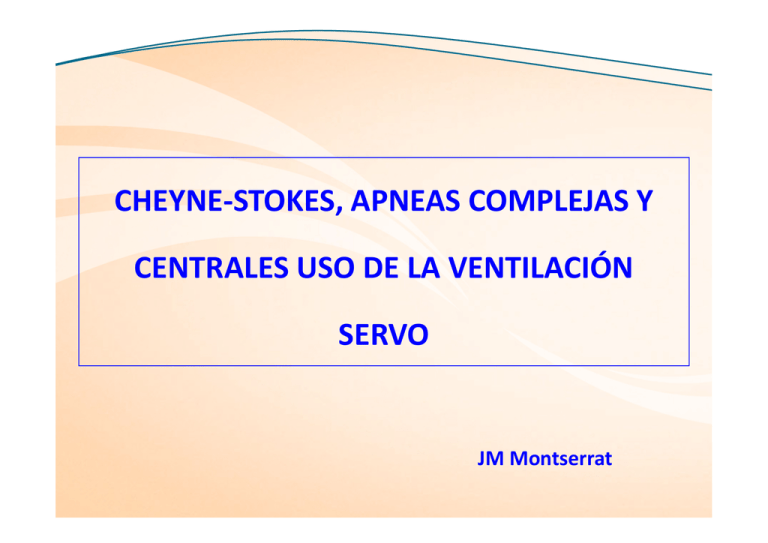
CHEYNE‐STOKES, APNEAS COMPLEJAS Y CENTRALES USO DE LA VENTILACIÓN SERVO JM Montserrat 1. Introducción 2. Apneas 3. Servo ventilación 1. Introducción 2. Apneas 3. Servo ventilación Upper airway mechanoreceptors Negative pressure Vibration 2 UPPER AIRWAY PATENCY /COLLAPSE UPPER AIRWAY FACTORS: (+) 1 BRAIN STEM CENTERS UPPER AIRWAY MUSCLES (-) ANATOMIC Obesity, retrognatia… COLAPSABILYTY Shape Tissue properties Apnea Dempsey et al. Pathophysiology of Sleep Apnea. Physiol Rev 2010; 47–112 Upper airway mechanoreceptors Negative pressure Vibration 2 UPPER AIRWAY PATENCY /COLLAPSE UPPER AIRWAY FACTORS: (+) 1 BRAIN STEM CENTERS UPPER AIRWAY MUSCLES (-) ANATOMIC Obesity, retrognatia… COLAPSABILYTY Shape Tissue properties Apnea ǀZǀ (cmH2O*s/l) Pes (cmH2O) V’ (l/s) 1 0 -1 5 0 -15 20 0 Kimoff et al 2009. 1. Introducción 2. Apneas 3. Servo ventilación 1. No Pueden • Obstructivas 2. No Quieren • Centrales 3. Patrón Respiratorio Irregular • Cheyne‐ Stokes, Apnea compleja LAS OBSTRUCTIVAS Oxidative stress Systemic inflammation Endothelial dysfunction Fragmented and non-restorative sleep (somnolence, cognitive..) Adipokines Hypertensión Metabolic disturbances Large negative intrathoracic Large negative intrathoracicpressures pressures Arteriosclerosis CARDIAC OVERLOAD Caples 2005. Modified SAHS CARDIOVASCULAR OBESIDAD Intermittent air Intermittent air High cholesterol diet CIH CIH high High cholesterol diet Mice exposed to CIH and high-cholesterol diet developed atherosclerotic lesions in the aortic origin and descending aorta. 4 weeks (cross-sections of the aortic origin, using oil red O stain) Vladimir Savransky. AJRCCM 2007 1. No Pueden • Obstructivas 2. No Quieren • Centrales 3. Patrón Respiratorio Irregular • Cheyne‐ Stokes, Apnea compleja CLASSIFICATION OF CENTRAL APNEAS • In hypercapnic subjects: - neurologic or muscle deficits • In hypocapnic or normocapnic subjects: - instability of the respiratory drive • Other central apneas M S Badr. Prim Care Clin Office Pract. 2005: 361–374 Complex sleep apnea and obesity hypoventilation syndrome opposite ends of the spectrum of OSA? Marrone, Med Hypoth 2009 Central Apneas (Complex) Hypoventilation (OHS) 1. No Pueden • Obstructivas 2. No Quieren • Centrales 3. Patrón Respiratorio Irregular • Cheyne‐ Stokes, Apnea compleja LAS CHEYNE‐STOKES Cheyne, J. “A case of Apoplexy, in Which the Fleshy Part of the Heart Was Converted into Fat.” Dublin Hospital Reports, 1818, II, 216. 30 sec. 60 sec. …of a patient with probable cardiac asthma: “…For several days his breathing was irregular; it would entirely cease for a quarter of minute, then it would become perceptible, though very low, then by degrees it became heaving and quick, and then it would gradually cease again: this revolution in the state of his breathing occupied about a minute during which there were about thirty acts of respiration...” Stokes, W. “Observations on some Cases of permanently slow Pulse.” Dublin Quart. Jour. Med. Sc.,1846,II,83. “…Then a very feeble, indeed barely perceptible inspiration would take place, followed by another somewhat stronger, until at length high heaving, and even violent breathing was established, which would then subside till the next period of suspension… This was frequently a quarter of minute in duration this was 4a case of5. weakened 0 I have 1 little doubt 2 that 3 6 and probably 7 8fatty 9 heart, with disease of the aorta…” 10 PREVALENCIA OSA EN LA INSUFICIENCIA CARDIACA Does CSR worsen prognosis in CHF patients? Yumino and Bradley: Cheyne‐Stokes Respiration with Central Sleep Apnea Proc Am Thorac Soc, 2008 Awake ventilation Regular nonREM ventilation transition NREM PCO2 below apnea threshold central apnea PCO2 above apnea threshold ++ ventilation ++ Increasing PCO2 Xie et al., AJRCCM 1994;150:489-95 High ventilatory response to CO2 arousal Sin et al. Circulation, 2000 CANPAP: Survival Analysis Heart-Transplantation-free Survival Bradley, T. et al. N Engl J Med 2005 No effect of CPAP on survival in CHF+CSA (CanPAP) Bradley et al. N Engl J Med 2005; 353: 2025-2033 Post-hoc analysis Artz et al. Circulation 2007; 115: 3173-3180 OSA EN LA INSUFICIENCIA CARDIACA MOTIVOS PARA CONSIDERAR SU TRATAMIENTO HIPOXIA Y AROUSALS: Activación simpática, inflamación SUEÑO FRAGMENTADO: Activación simpática, cansancio diurno p, posa somnolencia MAYOR MORTALIDAD Y MORBILIDAD: ? DETERIORO MAS RÁPIDO DE LA INSUF. CARDIACA: ? 1. No Pueden • Obstructivas 2. No Quieren • Centrales 3. Patrón Respiratorio Irregular • Cheyne‐ Stokes, Apnea compleja Complex apnea is defined by the development of central apnea in the OSA patient during the initial CPAP titration. (treatment‐emergent central apnea) COMPLEX SLEEP APNEA At diagnosis: OSAS During CPAP: obstructive events abolished, But: central apnea index ≥5 or large amount of periodic breathing Breakpoint: CPAP level above which respiratory periodism worsens or central apneas appear Natural history of CompSA in OSA patients Javaheri et al. J Clin Sleep Med 2009; 5: 205-211 • Retrospective analysis on over 1200 OSA patients • Prevalence estimated at 6.5% • AHI on CPAP decreased over time, but did not normalize in 1.5% of patients • Risk factors for persistent CSA: – Severe OSA – High central apnea index at diagnosis – Use of opioids Studies on flow-triggered ASV in CHF patients with OSA+CSR Study Intervention n Duration Results 14 CHF 2 nights ↓ AHI, flow-triggered ASV well tolerated Randerath et Flow-triggered al, Sleep ASV Med 2008 10 (6 CHF) 8 weeks ↓ AHI and arousals in pts with and without CHF Kasai et al, Circ Heart Fail 2010 31 CHF 3 months Better results in flowtriggered ASV group (↓ AHI, ↑ LVEF, QoL and compliance) Artz et al, Chest 2008 Acute CPAP or BiPAP vs flowtriggered ASV RCT flowtriggered ASV vs CPAP Flow-triggered ASV (dynamic BiPAP): Titration EPAP = 4 cm H2O IPAPmin = EPAP IPAPmax = IPAPmin + 10 cm H2O Automatic back-up rate Obstructive events No Central Apneas No Continued PB pattern Yes Yes Yes EPAP ↑ by 1 cmH2O (up to 10) Back-up rate ≥10 breaths/min IPAP max ↑ by 2 cmH2O No Final setting Kasai et al. Circ Heart Fail 2010; 3: 140-148 Studies on ASV in CHF patients Study Intervention n Duration Results Pepperell et al, 2003 RCT ASV therapeutic vs subtherapeutic 39 1 month CHFCSR ↓ sleepiness, AHI, BNP, urinary catechol. in therapeutic ASV group Philippe et al, 2006 RCT CPAP vs ASV 25 6 months CHFCSR ↓ AHI, ↑ LVEF, better compliance and QoL in ASV group Fietze et al, 2008 RCT BiPAP S/T vs ASV 6 weeks 39 CHFCSR ↓ AHI, ↑ LVEF in both groups Hastings et al, 2010 ASV vs no ventilatory treatment (declined ASV) 6 months 19 CHFCSR ↓ AHI, ↑ LVEF, ↑ QoL, BNP= in ASV group Koyama et al, 2010 ASV vs no ventilatory treatment (declined ASV) 17 4 weeks CHFCSR ↓ AHI, ↓ BNP, ↓ hsCRP in ASV group Patient Characteristics • • • > 90% are Male • Higher incidence of ischemic heart disease or CHF Prevalence of 10‐15% in OSA Patients BMI is slightly less than average OSA patient? Polysomnographic Characteristics May have evidence of central events on baseline PSG Events more common in nREM sleep Elevated Arousal Index Possible Reduction in Central Events on future follow‐up Clinical Impact of nCPAP in “Complex Apnea” Residual or Worsening Symptoms (Fatigue, EDS, Depression) Secondary to Arousals/Disrupted Sleep Higher Incidence of “CPAP Difficulty” ↑ Sympathetic Activity? of ↑ Mortality COMPLEX SLEEP APNEA Definition of Complex Sleep Apnea Causes of Central Apnea Developing on CPAP Therapy Treatment Options Implications of the Syndrome COMPLEX SLEEP APNEA Definition of Complex Sleep Apnea Causes of Central Apnea Developing on CPAP Therapy Treatment Options Implications of the Syndrome Treatment Considerations in Complex Apnea 1. Increase CO2 Reserve Value A. ? O2 B. ? Induce Acidemia C. Increase Dead Space 2. Reduce Loop Gain A. Treat CHF B. ? Sedatives 3. Provide Back‐Up A. Backup Rate on Therapy Treatment Options nCPAP with Permissive Flow Limitation Supplemental O2 Medications Acetazolamide Theophylline Benzodiazepines Additional Dead Space to nCPAP Positive Airway Pressure Gas Modulation Adaptive Servo Ventilation (ASV) Implications 1. To OSA Patient 15% will not respond to nCPAP Cost of Alternative Therapies may be Prohibitive 2. To Sleep Centers Responsibility to Identify such patients and offer Treatment Modifications 3. To Sleep Medicine Society Consider Consequences in Offering Home Studies (Non‐Titrated) as well as Automated CPAP Future Questions and Goals Clarify Definition and Natural History of Complex Sleep Apnea Improve Identification Process of At‐Risk Patient Improvement in Technology Utilized in making the Diagnosis Develop Treatment Options that are Cost‐Effective 1. Introducción 2. Apneas 3. Servo ventilación Adaptive Pressure Support Servo‐ventilation (APPSV) Untreated Cheyne‐Stokes Respiration Treated Cheyne‐Stokes Respiration Teschler; AJRCCM 2001 OBJETIVO Estabilizar la ventilación (C‐S y suprimir el “open loop”) METODOLOGÍA Medir la ventilación previa of basal o la que supuestamente tiene el individuo Valorar si las apneas son centrales u obstructivas Si son obstructivas aumentar el EPAP Si son centrales aumentar la IPAP de un modo sincronizado Confort del paciente RESULTADOS FINALES A ALCANZAR Mejorar la calidad de vida, morbilidad y mortalidad Estimar la ventilación basal del paciente Mantener las ventilación Análisis de los 1-4 minutos previos estimada durante el sueño D Navajas AJRCCM 1998 D Navajas AJRCCM 1998 5 cm H2O 6 cm H2O Pressure Settings •EPAPMIN = 4 cm H2O, EPAPMAX =15 cm H2O •PS MIN = 0 cm H2O, PS MAX = 15 cm H2O •Maximum (IPAP) pressure, P MAX =25 cm H2O •Back‐up rate : Auto •Bi‐Flex : OFF •Alarms: All must be disabled Effectiveness of Different Therapies in CSA Teschler H et. al; AJRCCM 2001 ASV vs. CPAP for CSA in HF * p <0.05 * * C. Philippe et al., Heart 2006;92:337 * * MIS CONCLUSIONES Los trabajos iníciales siguieren su utilidad Hacen falta mas estudios con una población mas amplia dirigidos no solo a si el equipo funciona bien o no, sino si reduce la comorbilidad y mortalidad No existen trabajos negativos Equipos sofisticados Es imprescindible exigir a la empresas equipos robustos mas que excesivamente superinteligentes MIS CONCLUSIONES La titulación es probablemente imprescindible No todos lo pacientes van a adaptarse inicialmente y pueden requerir varios estudios Entreno educación a los pacientes y médicos es completamente necesaria Los ASV no deben de ser utilizados como “black box”
